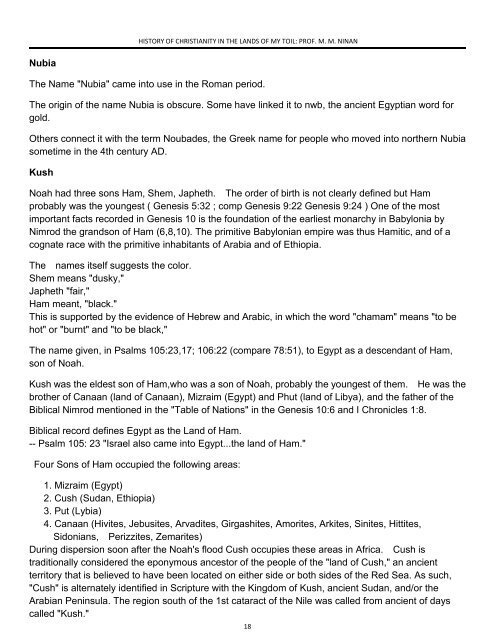Historyof Christianity in the lands of My Toil
You also want an ePaper? Increase the reach of your titles
YUMPU automatically turns print PDFs into web optimized ePapers that Google loves.
HISTORY OF CHRISTIANITY IN THE LANDS OF MY TOIL: PROF. M. M. NINAN<br />
Nubia<br />
The Name "Nubia" came <strong>in</strong>to use <strong>in</strong> <strong>the</strong> Roman period.<br />
The orig<strong>in</strong> <strong>of</strong> <strong>the</strong> name Nubia is obscure. Some have l<strong>in</strong>ked it to nwb, <strong>the</strong> ancient Egyptian word for<br />
gold.<br />
O<strong>the</strong>rs connect it with <strong>the</strong> term Noubades, <strong>the</strong> Greek name for people who moved <strong>in</strong>to nor<strong>the</strong>rn Nubia<br />
sometime <strong>in</strong> <strong>the</strong> 4th century AD.<br />
Kush<br />
Noah had three sons Ham, Shem, Japheth. The order <strong>of</strong> birth is not clearly def<strong>in</strong>ed but Ham<br />
probably was <strong>the</strong> youngest ( Genesis 5:32 ; comp Genesis 9:22 Genesis 9:24 ) One <strong>of</strong> <strong>the</strong> most<br />
important facts recorded <strong>in</strong> Genesis 10 is <strong>the</strong> foundation <strong>of</strong> <strong>the</strong> earliest monarchy <strong>in</strong> Babylonia by<br />
Nimrod <strong>the</strong> grandson <strong>of</strong> Ham (6,8,10). The primitive Babylonian empire was thus Hamitic, and <strong>of</strong> a<br />
cognate race with <strong>the</strong> primitive <strong>in</strong>habitants <strong>of</strong> Arabia and <strong>of</strong> Ethiopia.<br />
The names itself suggests <strong>the</strong> color.<br />
Shem means "dusky,"<br />
Japheth "fair,"<br />
Ham meant, "black."<br />
This is supported by <strong>the</strong> evidence <strong>of</strong> Hebrew and Arabic, <strong>in</strong> which <strong>the</strong> word "chamam" means "to be<br />
hot" or "burnt" and "to be black,"<br />
The name given, <strong>in</strong> Psalms 105:23,17; 106:22 (compare 78:51), to Egypt as a descendant <strong>of</strong> Ham,<br />
son <strong>of</strong> Noah.<br />
Kush was <strong>the</strong> eldest son <strong>of</strong> Ham,who was a son <strong>of</strong> Noah, probably <strong>the</strong> youngest <strong>of</strong> <strong>the</strong>m. He was <strong>the</strong><br />
bro<strong>the</strong>r <strong>of</strong> Canaan (land <strong>of</strong> Canaan), Mizraim (Egypt) and Phut (land <strong>of</strong> Libya), and <strong>the</strong> fa<strong>the</strong>r <strong>of</strong> <strong>the</strong><br />
Biblical Nimrod mentioned <strong>in</strong> <strong>the</strong> "Table <strong>of</strong> Nations" <strong>in</strong> <strong>the</strong> Genesis 10:6 and I Chronicles 1:8.<br />
Biblical record def<strong>in</strong>es Egypt as <strong>the</strong> Land <strong>of</strong> Ham.<br />
-- Psalm 105: 23 "Israel also came <strong>in</strong>to Egypt...<strong>the</strong> land <strong>of</strong> Ham."<br />
Four Sons <strong>of</strong> Ham occupied <strong>the</strong> follow<strong>in</strong>g areas:<br />
1. Mizraim (Egypt)<br />
2. Cush (Sudan, Ethiopia)<br />
3. Put (Lybia)<br />
4. Canaan (Hivites, Jebusites, Arvadites, Girgashites, Amorites, Arkites, S<strong>in</strong>ites, Hittites,<br />
Sidonians, Perizzites, Zemarites)<br />
Dur<strong>in</strong>g dispersion soon after <strong>the</strong> Noah's flood Cush occupies <strong>the</strong>se areas <strong>in</strong> Africa. Cush is<br />
traditionally considered <strong>the</strong> eponymous ancestor <strong>of</strong> <strong>the</strong> people <strong>of</strong> <strong>the</strong> "land <strong>of</strong> Cush," an ancient<br />
territory that is believed to have been located on ei<strong>the</strong>r side or both sides <strong>of</strong> <strong>the</strong> Red Sea. As such,<br />
"Cush" is alternately identified <strong>in</strong> Scripture with <strong>the</strong> K<strong>in</strong>gdom <strong>of</strong> Kush, ancient Sudan, and/or <strong>the</strong><br />
Arabian Pen<strong>in</strong>sula. The region south <strong>of</strong> <strong>the</strong> 1st cataract <strong>of</strong> <strong>the</strong> Nile was called from ancient <strong>of</strong> days<br />
called "Kush."<br />
18

















